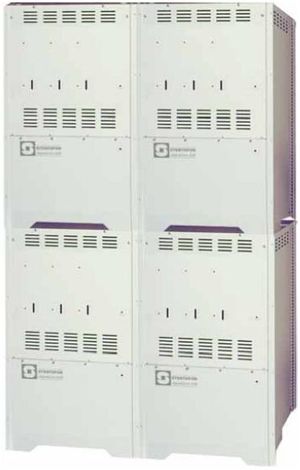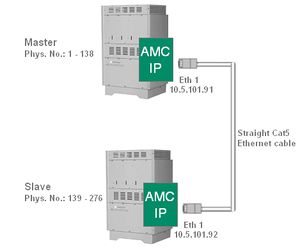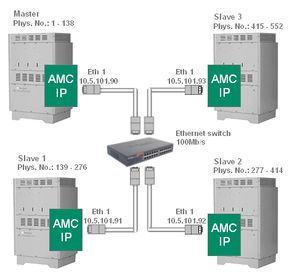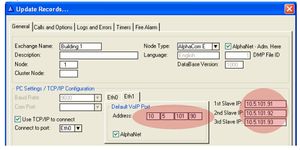Difference between revisions of "MultiModule"
From Zenitel Wiki
(→Autonom mode) |
(→IP network - VoIP) |
||
| Line 30: | Line 30: | ||
== Module interconnections == | == Module interconnections == | ||
| − | ===IP network - VoIP=== | + | ===IP network - VoIP=== |
| + | When using MultiModule over IP no additional AlphaCom hardware required. The connections are point to point, and not in a ring as in traditional MultiModule using AGA or AE1 boards. | ||
| + | |||
| + | The modules should be on the same LAN, as MultiModule uses fixed jitter buffer size of 10 ms | ||
| + | |||
| + | |||
====Cabling==== | ====Cabling==== | ||
The the modules together via a single Ethernet cable. Two modules can be connected back to back. A straight cat5 ethernet cable can be used. With three or four modules an ethernet switch is required. | The the modules together via a single Ethernet cable. Two modules can be connected back to back. A straight cat5 ethernet cable can be used. With three or four modules an ethernet switch is required. | ||
Revision as of 01:18, 11 December 2007
The STENTOFON AlphaCom E MultiModule function makes it possible to increase the capacity of an exchange by adding up to four AlphaCom E exchange cabinets together in a master-slave configuration. The multi-module exchange acts as one node with full integration of all features. In some documents multi-module is refered to as InterCardCage, ICC.
All configuration data are stored on the AMC-IP board in the master module. The master module controls the resources in the slave modules using the ICC Protocol.
The multi-module exchange supports redundancy mode. In case of master-slave communication error, the slave module will fallback to work as an individual exchange serving calls between stations connected directly to the exchange module.
Contents
Overview
The MultiModule acts as one exchange with full integration of features.
The connection between the modules is via IP network similar to AlphaNet.
- MultiModule is recommended when the modules are located in the same building/complex
- AlphaNet is recommended when the modules are located apart from each other
The main features of AlphaCom E IP-Based MultiModules are:
- Same high degree of feature integration as traditional MultiModules
- No additional AlphaCom hardware required
- Licenses are needed in each of the modules<br\>-The license key is common for AlphaNet and MultiModule<br\>-Licenses are by default used for MultiModule<br\>-MultiModule always use VoIP connections in a dynamic way
- Point to point connections (not in a ring as in traditional MultiModules)
- The modules do not need to be on the same LAN
- MultiModule uses fixed jitter buffer size of 10 ms
Autonom mode
The multi-module exchange supports redundancy mode. In case of master-slave communication error, the slave module will fallback to work as an individual exchange serving calls between stations connected directly to the exchange module. The AMC Master can be set to copy its content to the slave modules over a 28 hour period. In AlphaPro, Exchange & System > System > Calls & Options, set the flag "Autonom Mode: Copy NVRAM".
Module interconnections
IP network - VoIP
When using MultiModule over IP no additional AlphaCom hardware required. The connections are point to point, and not in a ring as in traditional MultiModule using AGA or AE1 boards.
The modules should be on the same LAN, as MultiModule uses fixed jitter buffer size of 10 ms
Cabling
The the modules together via a single Ethernet cable. Two modules can be connected back to back. A straight cat5 ethernet cable can be used. With three or four modules an ethernet switch is required.
Programming
Enter the IP address of the slave modules and connect
Licenses are required for each AlphaCom E module. Two modules can be connected back to back. A straight cat5 ethernet cable can be used. With three or four modules an ethernet switch is required.
- Perform a cold start to each module separately
- AlphaWeb:<br\>-Assign an IP Adress to each module<br\>-Enter the license key to enable the VoIP channels
- AlphaPro:<br\>-Enter the IP adress of the slave modules.
E1 link - AE1
Analog links - AGA
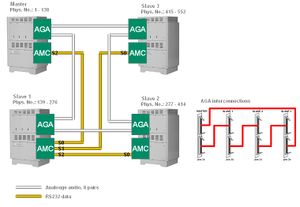
Installation
Limitations in Slave Modules
Slave modules support analogue stations only, no other types of inputs or outputs. Only the master module supports:

